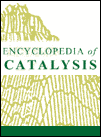Oxygenates Synthesis—Homogeneous
Abstract
The current status of direct (from CO/H2) and indirect (via methanol, formaldehyde, dimethyl ether, or methyl acetate) homogeneously catalyzed C1 chemistry based routes for the selective production of methanol, ethanol, and ethylene glycol (including higher alcohols, diols, and acetate esters), acetic acid, propionic acid and methyl propionate, ethyl and vinyl acetate, acetic anhydride, and methyl formate is described. Whereas none of the direct routes have been commercialized, largely because of low catalytic activities and extreme operating pressure requirements, indirect routes including the Co-, Rh-, and Ir-catalyzed carbonylation of methanol to acetic acid, Rh-catalyzed carbonylation of methyl acetate to acetic anhydride (and coproduction of both), and Pd-catalyzed methoxycarbonylation of ethylene to methyl propionate comprise established commercial processes. The majority of these transformations are uniquely homogeneously catalyzed.
Although mechanistic pathways associated with the carbonylation of methanol to acetic acid are well established, uncertainty still surrounds the mechanism of the initial step in the reduction of CO, to a putative formyl intermediate, during its direct conversion to oxygenates. A characteristic mechanistic feature of the latter chemistry is the operation of kinetic reaction control that is manifest in the absence of the thermodynamically favored products, hydrocarbons (particularly methane); with the exception of catalysts for methanol manufacture, this behavior is in sharp contrast to that of typical heterogeneous catalysts for synthesis gas reactions.



